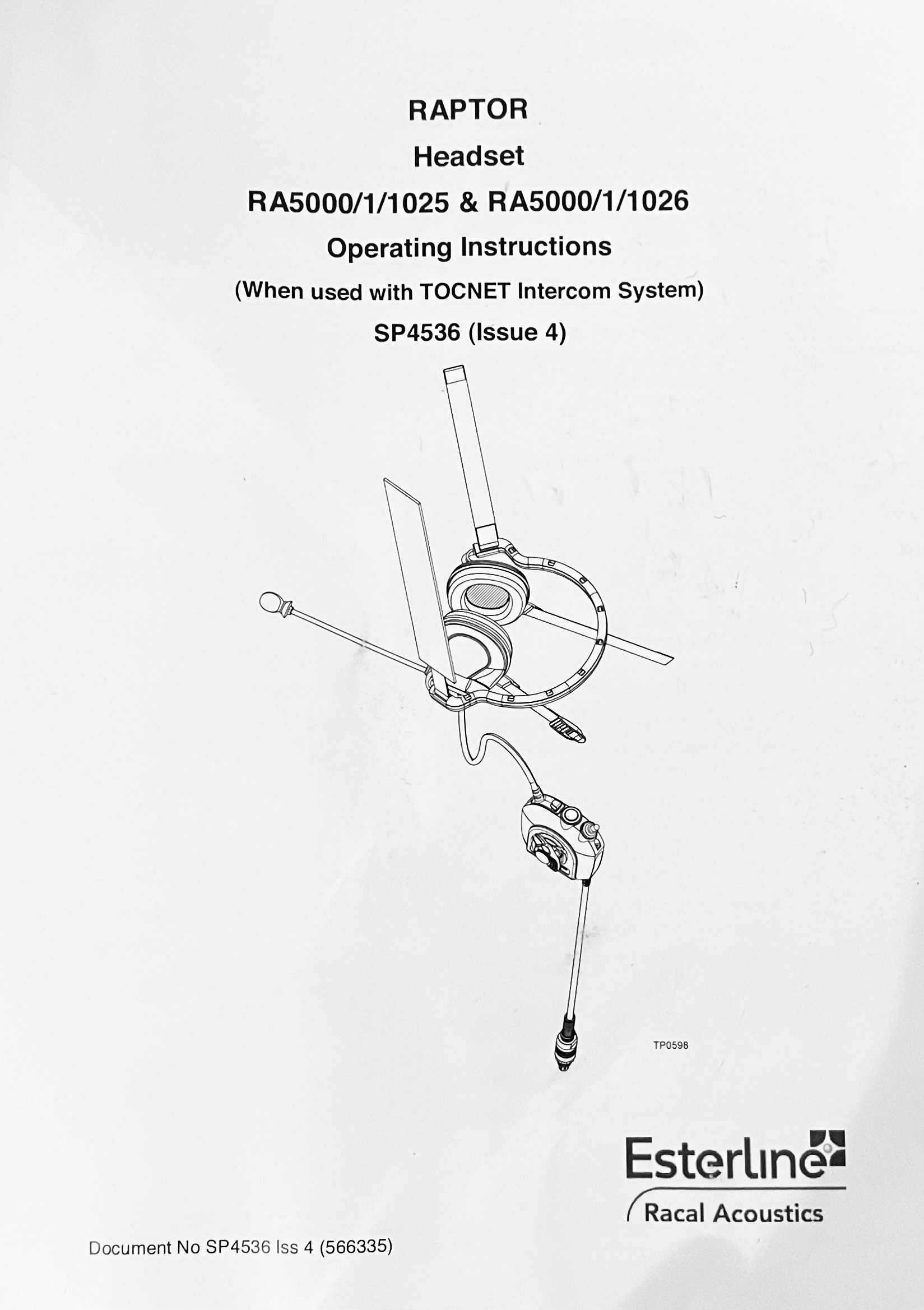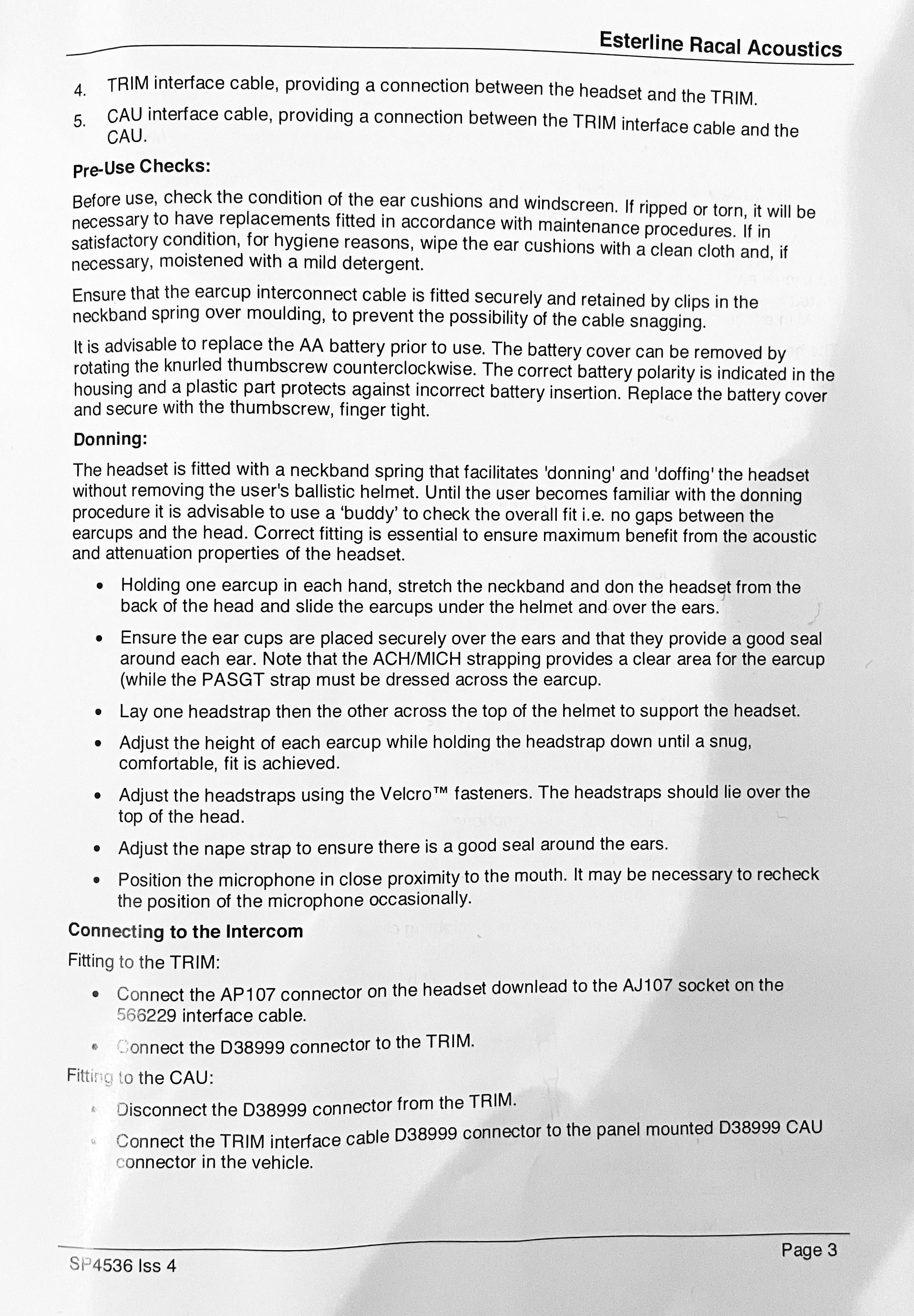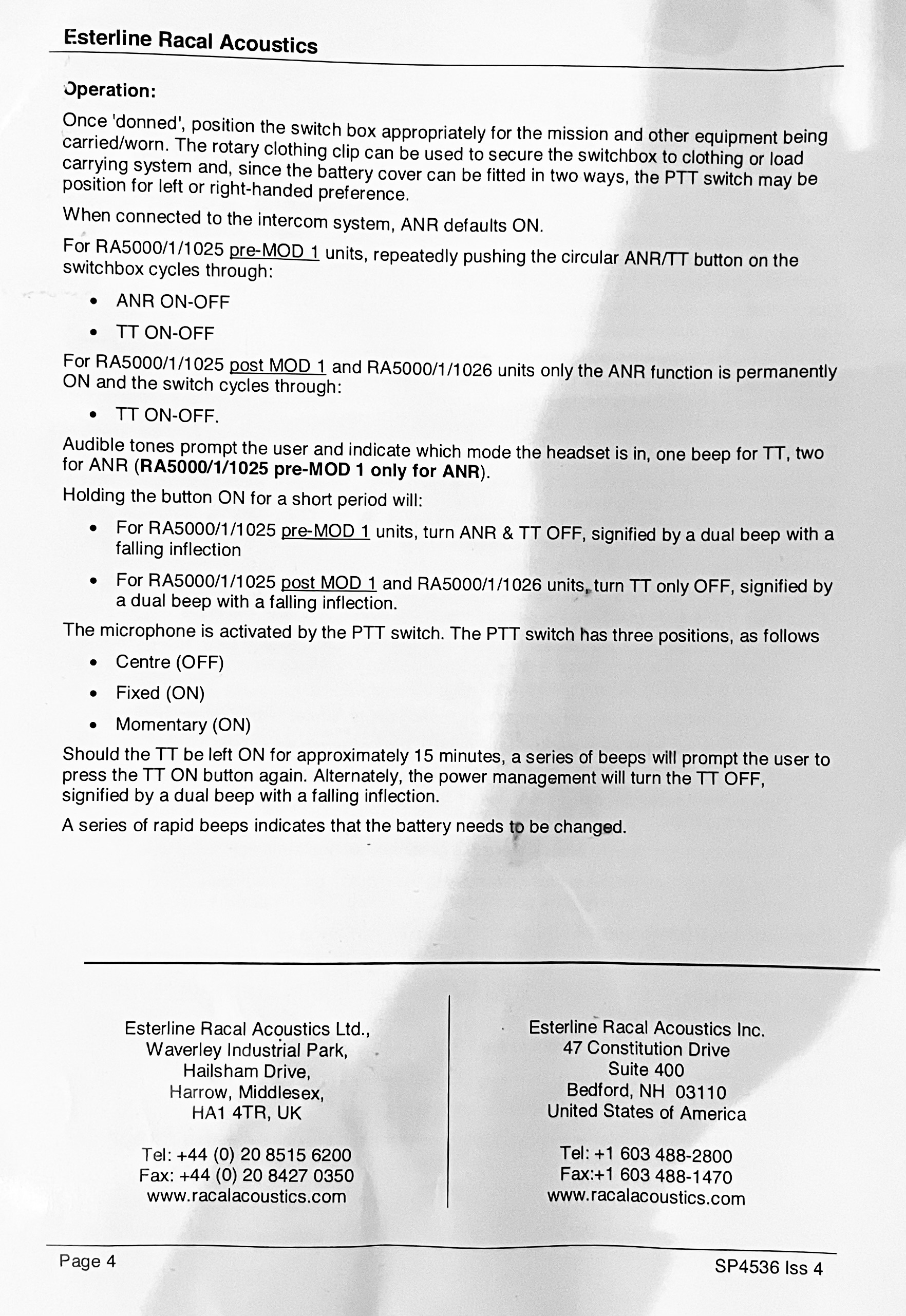Racal RA5000 "Raptor" Headset

The Racal Acoustics RA5000 "Raptor" is a military-grade hearing protection/headset, in this article we'll be looking closer at the RA5000/1/1025 model.
This headset is available in a variety of modified configurations, the specific model I have seems to be intended for use with a TOCNET intercom system. Prices for this model sit around $50-100 on eBay at the time of writing.
I wasn't able to find a solid lead on how old this model is, most of the documentation available is for a slightly upgraded RA5001 model. Given the internals shown later it's likely an early 2010's or late 2000's design, though the basic design could be slightly older as this level of integration would likely be practical as early as 2000.
Modern devices of this class likely use modern low power DSP's to perform more intelligent noise filtering and cancellation but this is strictly analog affair, though a nicely built and implemented one.
Table of Contents
Headset Overview
The headset is a neck-band type suitable for use under combat helmets, a soft strap goes over the head and a rigid band goes behind the head to provide clamping force. This is one of generally two ways to do a combat headset — the other method seems favoured by Peltor and is to just attach the earpiece directly to the helmet.
A boom microphone is integrated in one ear-piece as usual. The datasheet notes that this can be swapped left/right easily but I don't really see how that would work without some new plastic covers as a minimum.

Comfort is quite good for being a fairly high noise rejection headset. Gel-pads seem to be used similar to but slightly stiffer than the Peltor ones. The headset is attached with a velcro-fastened over-head strap to keep it up, and a behind-head strap that provides clamping force on the ears. This arrangement allows the user to select how much clamping force is applied, allowing for improved comfort at the expense of isolation.
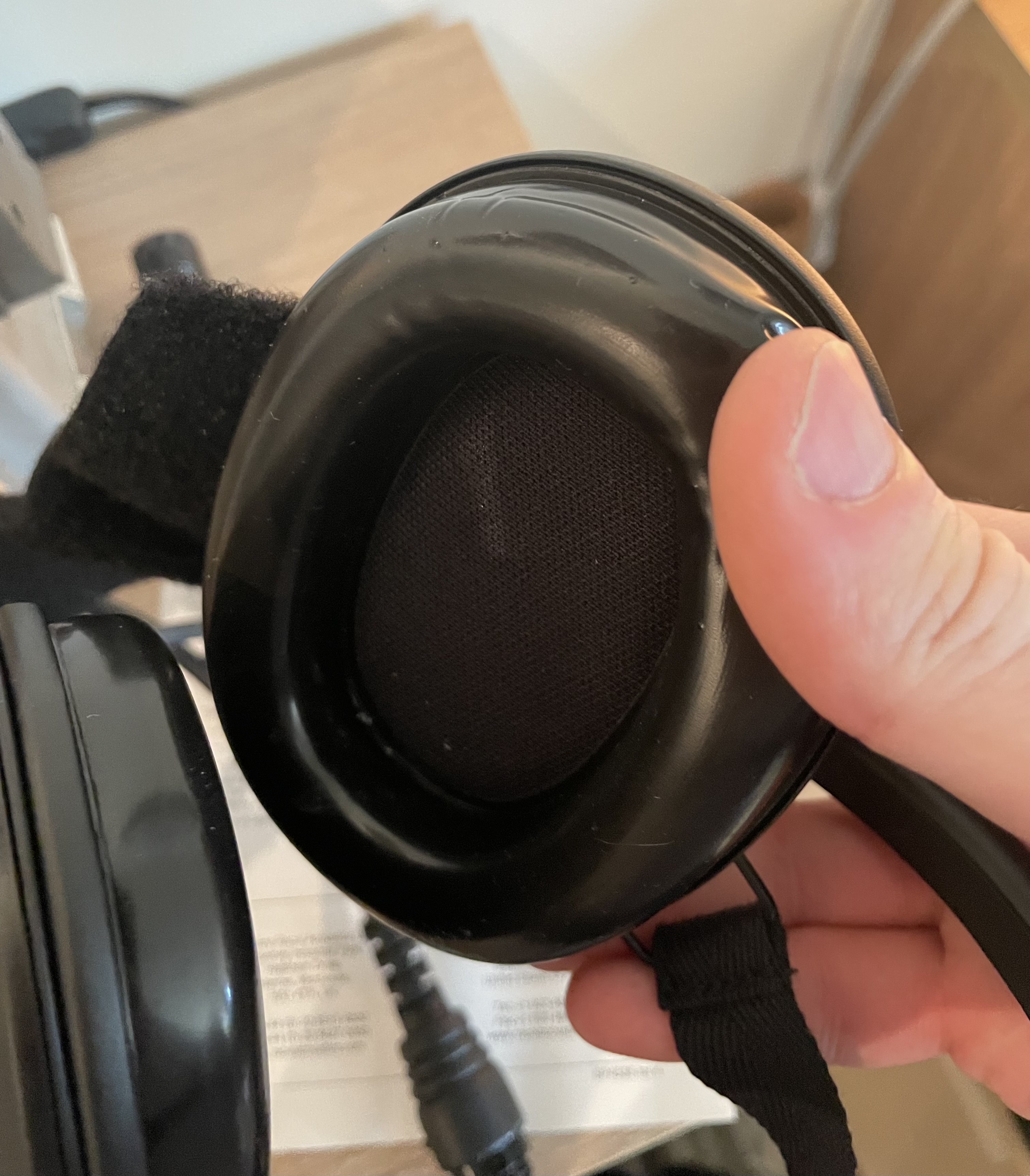
Informal comparisons found this headset in passive mode seems to have more rejection than the Peltor SportTac.
I have yet to find hearing protection that doesn't become sweaty and uncomfortable after an hour or two of use and this is no exception, but the amount of adjustability in the straps does make it possible to adjust it to change the pressure points.
PTT/Interface
A PTT/control block is permanently attached to the headset via a wire, and the headset connects to an external radio via a AP-107 7 pin breakaway connector. This connector is quite common, and while pinout and functionality is application specific, it generally includes headset audio, microphone, PTT, and power. It seems to be manufactured primarily by Amphenol Nexus with no MIL-number, and is intended as a waterproof break-away self-cleaning field connector. The AP/AJ-107 connector seems to only exist as a cable-cable connector, and is probably only used for this purpose.

The PTT can be powered by a single 1.5 V AA size battery, or from an external 13-36 V DC power source from the radio/intercom system.
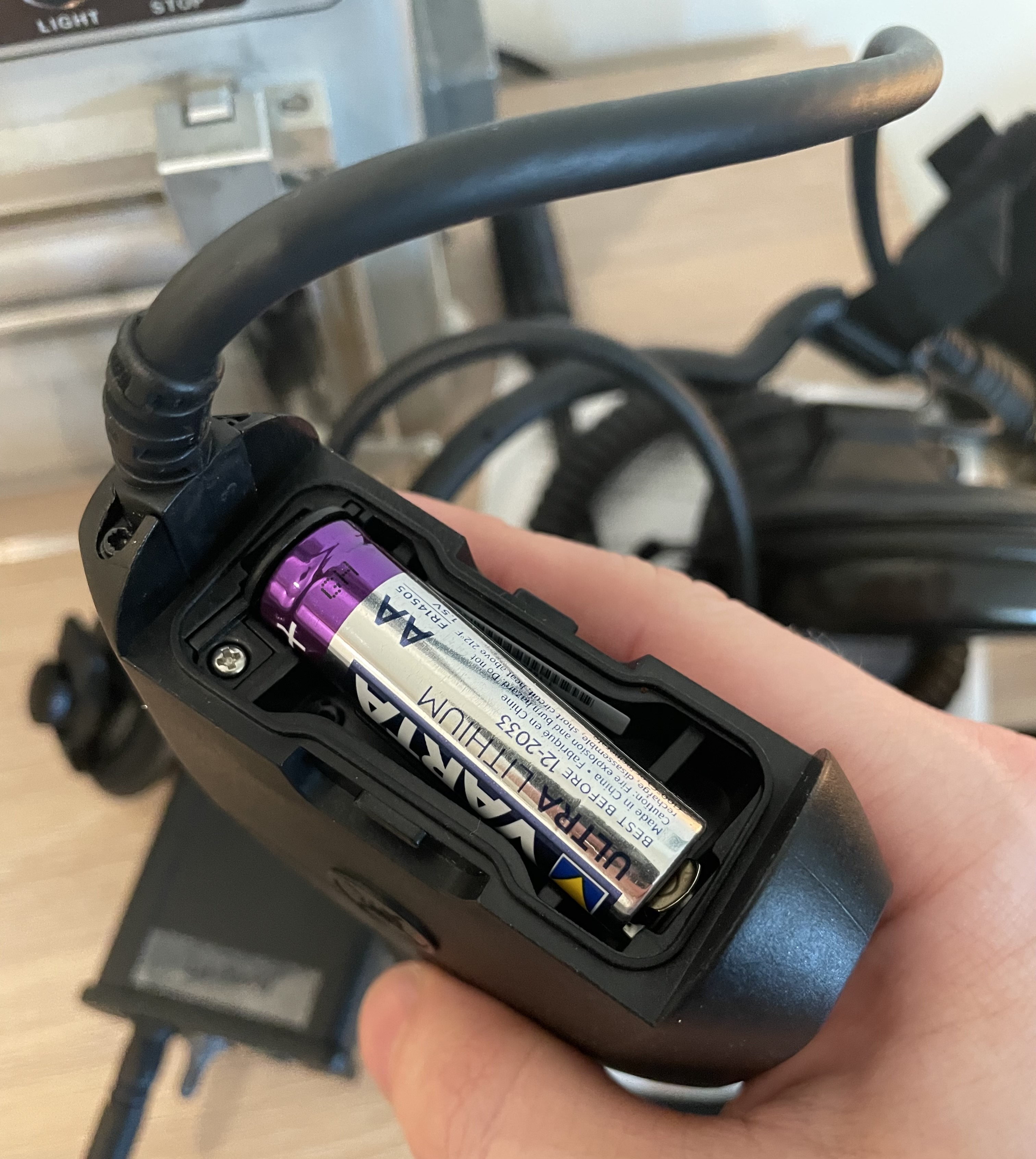
The PTT is a momentary-off-on toggle switch, the on-state connects a 470 Ω resistor to the PTT lines while the momentary-state is a short. This can easily be modified by opening the PTT and re-soldering if desired.
A small flap on the top of the PTT hides a gas-mask microphone connector. When the flap is opened a set of reed-switches switch the active microphone to this connector.
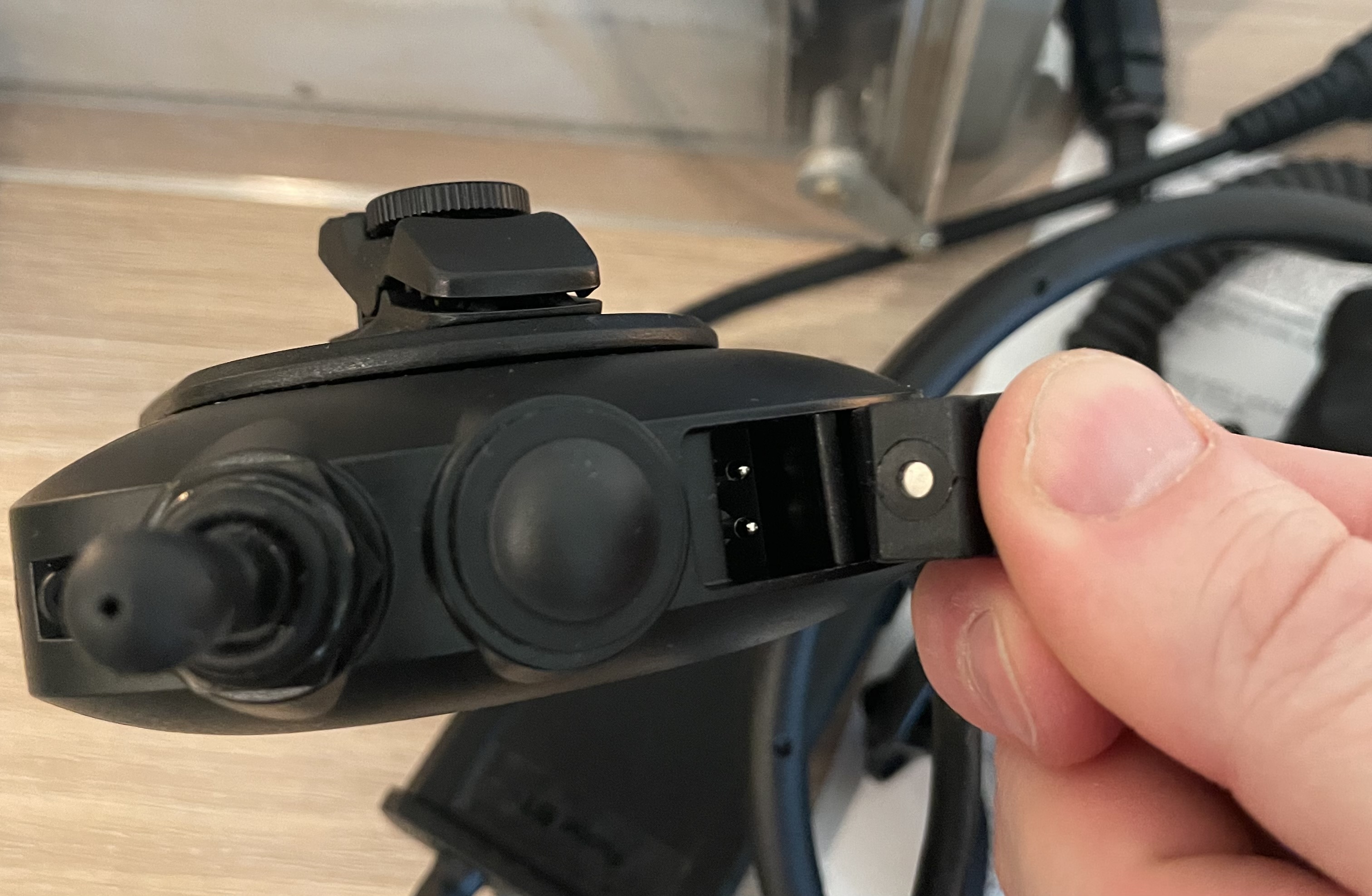
States & Modes
The headset has the following modes
- Unpowered, passive noise canceling, passive mic and speaker
- AA battery powered hear-through, passive mic and speaker?
- Powered, active & passive noise canceling, active mic and speaker
- Powered, better hear-through, active mic and speaker
Note that only mode 3 and 4 are really meant to be used with an external radio, since it's expected that whatever radio/intercom you plug in will have a power source to supply. Modes 1/2 are meant for dismounted use, but can technically be used with an external radio as well.
When powered externally, the microphone is amplified, and an active sound cancellation seems to be activated, which seems to use the ambient microphones to to cancel out external noise.
The active ANC is not massively effective at higher frequencies, but does a good job canceling low and low-mid tones (I'd guess it's useful to around 1 kHz max). It's very effective with e.g. engine rumbling, and it's pretty good when e.g. using a milling machine. It's also pretty nice to use with a talk-through microphone (must be done external to the headset) for longer conversations.
A datasheet lists attenuation values for this headset.
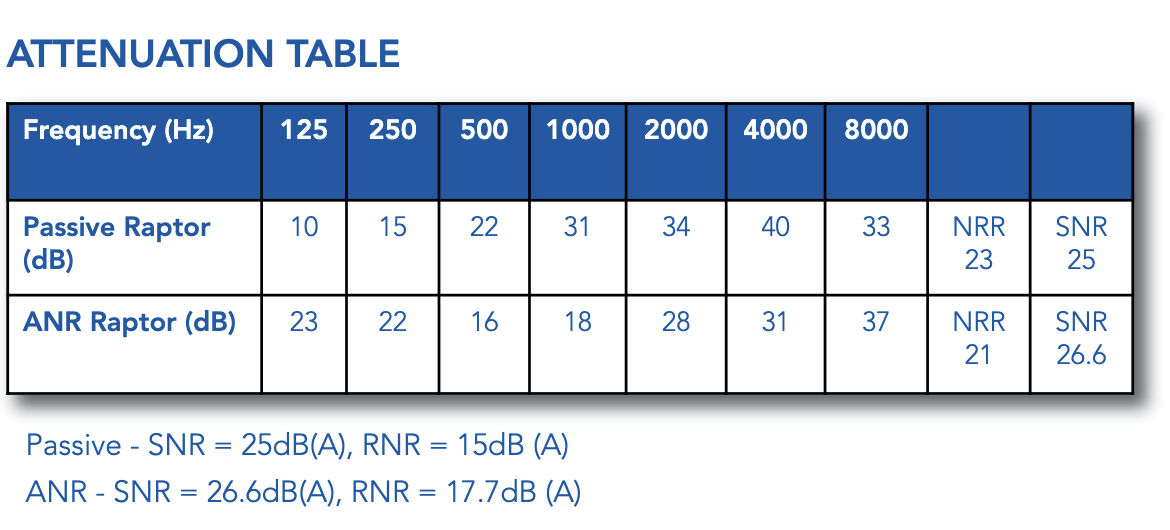
When powered by the AA battery, the talk-through mode can be used (provides ambient stereo sound through the headset). The talk-through mode in battery mode seems to have a slightly worse frequency response than the powered mode, and is slightly quieter.
Talk-through mode is specified as providing approximately equal sound levels as without the headset (seems accurate). The compression threshold is specified as 140 dB SPL, though my informal testing suggests some compressions starts in the 90-100 dB SPL range (tested by holding my phone speaker up against a SPL meter and the Racal ambient mics, battery mode.)
The Peltor SportTac for comparison has much lower compression thresholds, which can affect perceived sound somewhat, increasing subjective noise in a tiring way.
Below is a table of sensitivities for various modes, the sensitivity of -56 dBm for the ANR unpowered mode seems to line up with typical sensitivities for this type of microphone. The –32 dBm powered figure seems to approximately line up with expected figures for electret microphones. Note that no acoustic level is specified here, but I previously calculated that a H-250 handset has a nominal sensitivity of –56 dBm/2.8 Pa to this may be the reference pressure. (The difference between 2.8 and 1 Pa is fairly minimal)
The passive mode listed below is for a variant without electronics, but I'm not sure why the sensitivity is almost 30 dB less for the microphone there.
The internal microphone preamp is not the best in the world since it does add some slightly audible hiss, but it's acceptable for radio communications. The microphone itself has good acoustic noise canceling, it's possible to have a conversation while running a vacuum cleaner (90+ dBSPL) without issue (though some background noise will be present).
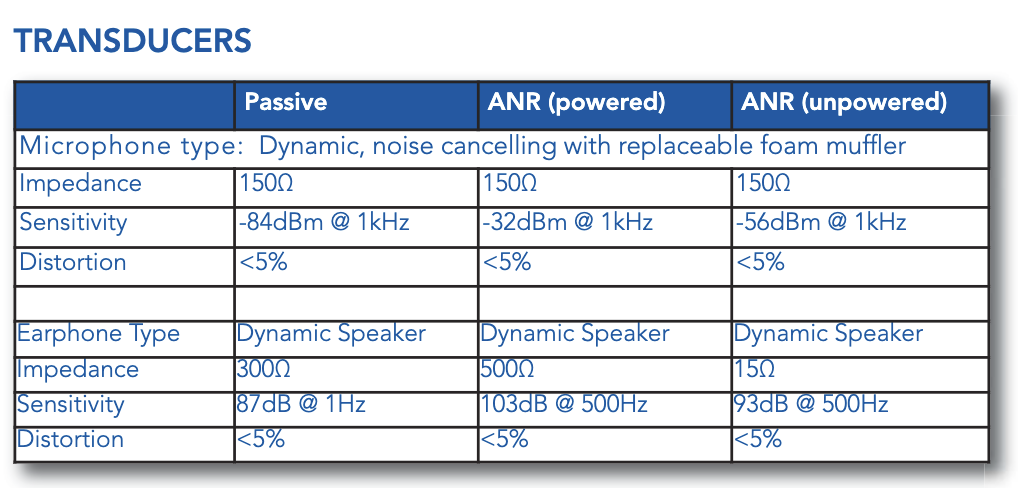
Above we can also note that the speaker characteristics change from a direct speaker connection in unpowered mode a high impedance amplified input in powered mode. Note that powered in this context means externally powered; in battery mode the speaker and microphones are both unamplified even when in talk-through mode.
In both internal and externally powered cases the push-button on the device is used to cycle between off/talk-through (AA battery) or ANC/talk-through (external power). An audible beep sequence gives feedback on what mode is selected, and the headset powers on to ANC mode when external power is applied.
Battery Life
The various versions of manuals list various battery life times ranging from 50-150 hours. This will certainly depend on the temperature and volume levels used.
I did some measurements in a reasonably quiet room and found the following current consumptions from a AA Lithium primary battery (at 1.7 V):
| State | Current | Batttery Life Estimate (L91) |
| Off | 5 µA | 700'000 hours (>10 years) |
| Talk-Through | 8 mA | 437.5 hours (18 days) |
For the above calculation the Energizer L91 "Ultimate Lithium" specification of approximately 3500 mAh for low-current loads was used. The off-state current is sufficiently low that the shelf life of the battery is the limiting factor in most cases.
Battery life with alkaline cells will be less, especially at lower temperatures. Lithium based primary batteries (Energizer/Varta sell largely equivalent batteries here) should perform approximately as well across the entire temperature range for this low current draw.
However, these measurements indicate that the manufacturers battery life estimates are likely quite conservative. Given the stated operation temperature range of –40 - +50°C I suspect their estimates assume an alkaline battery at –40°C, which is an extreme worst case and you might only get 10-20% capacity.
At least we know that leaving the batteries in won't drain them very quickly.
Pinout
My kit included a ”yoyo cord,” also known as a bailout-cable, it is a 13 pin 38999 socket connector to AJ-107 coiled extension cable. This is an extremely heavy and very long coiled cable that would be extremely impractical to walk around with, it connects to a TOCNET intercom system. It does give us a free AJ-107 plug that can relatively easily be disassembled and reused.
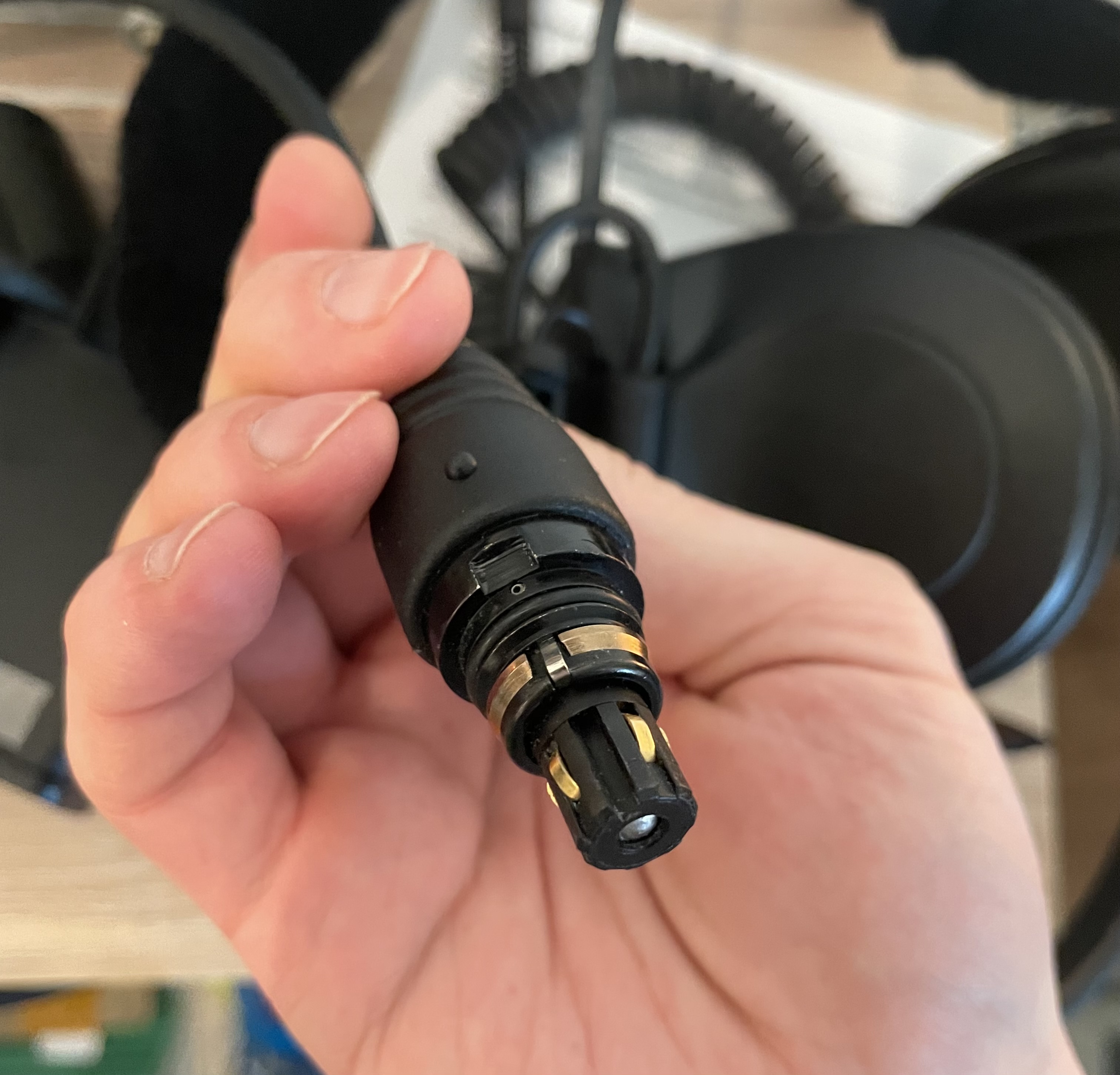
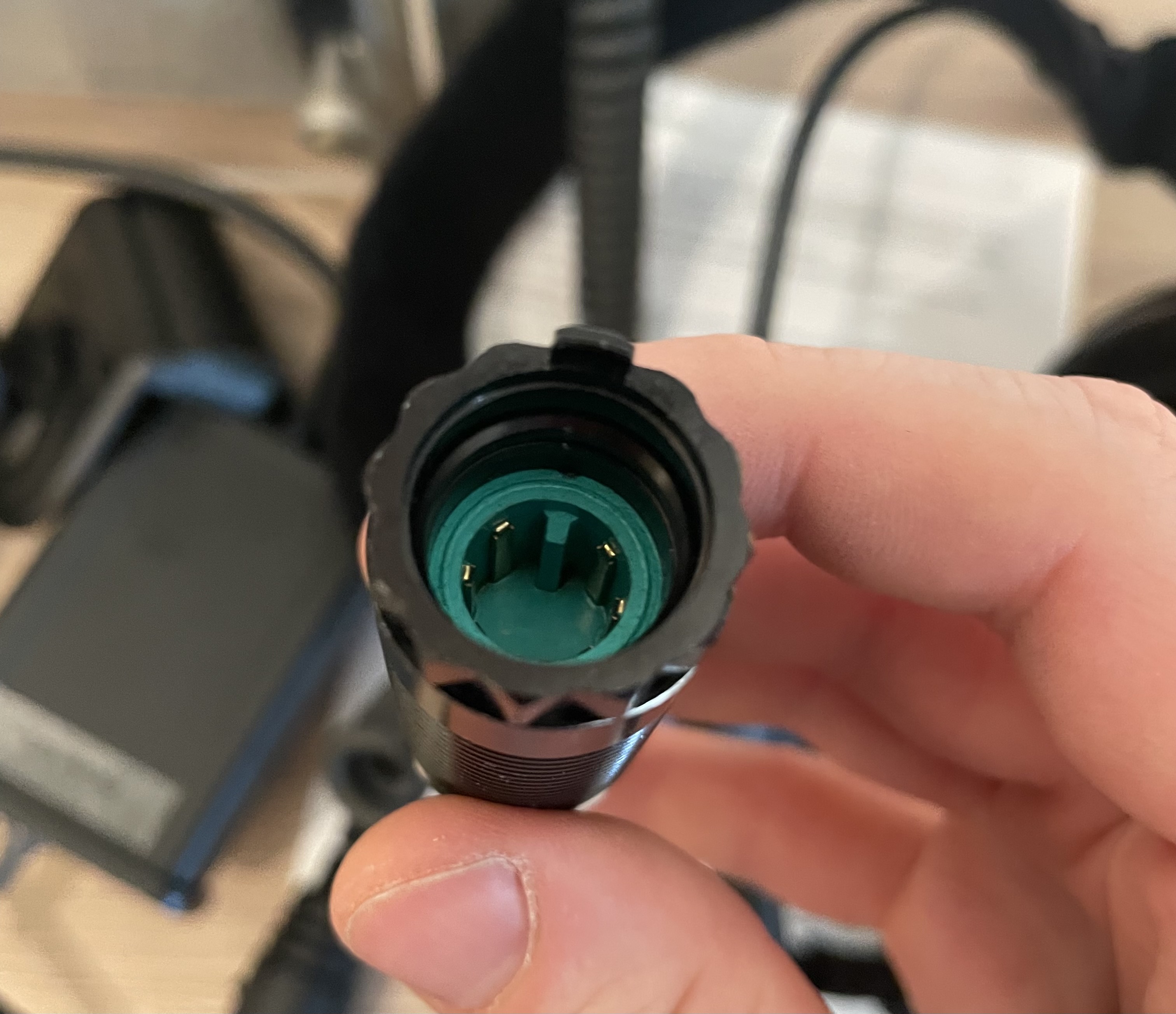
Pinouts use the Nexus pin numbers, which are viewed from the cable entry side (i.e. the side you'd solder the wires to when assembling the plug, mirrored from looking into the connector:
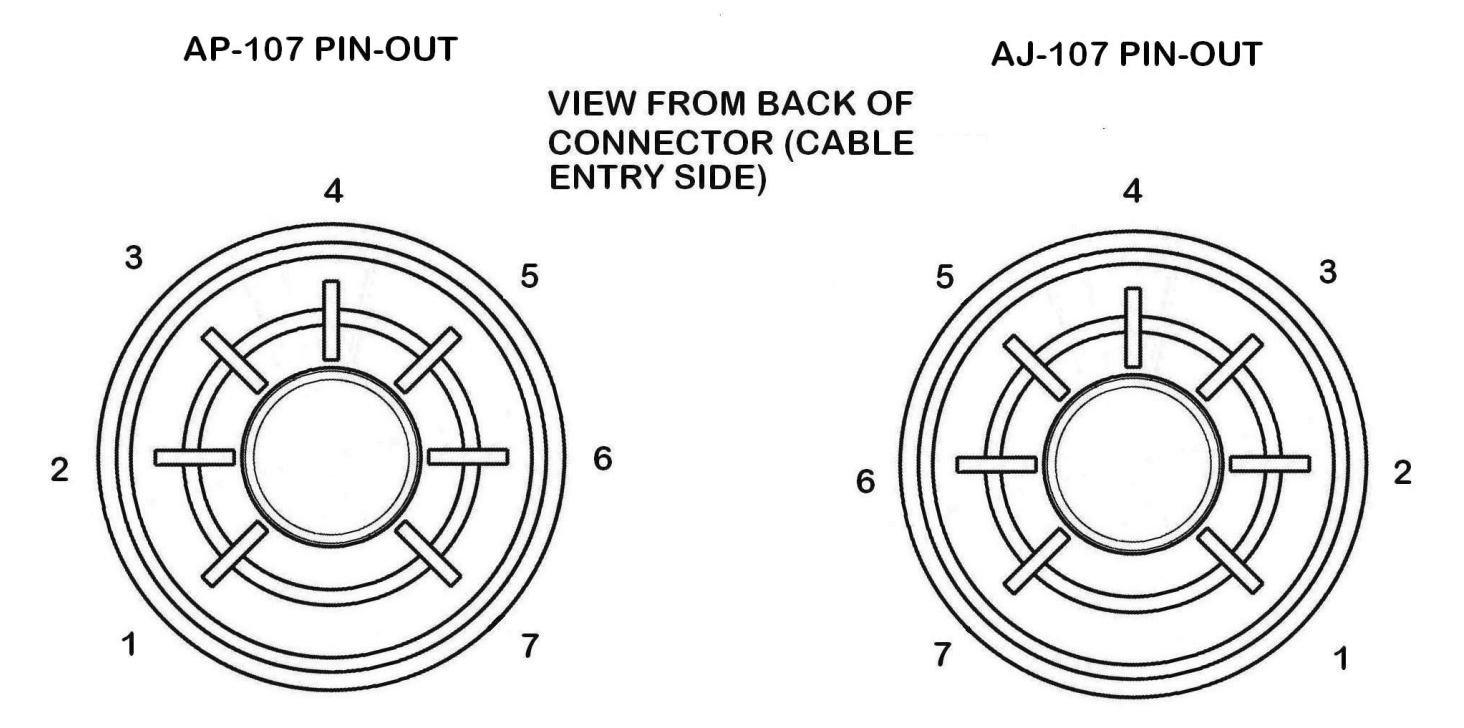
If you're looking into the mating side of e.g. the AP-107, then refer to the AJ-107 figure above.
| AP-107 | 38999 | Function | Note |
| 1 | N/C | N/C | Second audio in some models? |
| 2 | 6 | PTT | 0 Ω (470 Ω when latched) |
| 3 | 4 | GND | Common for speaker, PTT, Power |
| 4 | 2 | Microphone Return | Powered: Common to GND for amplified mic |
| 5 | 8 | 16 Ω Speaker | Powered: 500 Ω amplified |
| 6 | 1 | Microphone Signal | Powered: Amplified mic, electret levels |
| 7 | 12 | 13.5-36 VDC | Around 50 mA consumption |
Note that when powered externally (but not on batteries) the microphone is amplified to an electret-compatible level, but when unpowered the 150 Ω dynamic microphone is directly connected to the pins (directly connected, floating).
I'm not sure if the device uses dual speakers (one for radio, one for hear-through), or if the battery powered hear-through+comms mode is done using clever tricks.
External power seems to be selected when a voltage of at least 11 V or so is applied, though the specification is 13.5-36 V.
Internals
A full tear-down was not done, but the top of the PTT can easily be accessed by undoing two M3 DIN912 screws (2.5 mm allen-key).
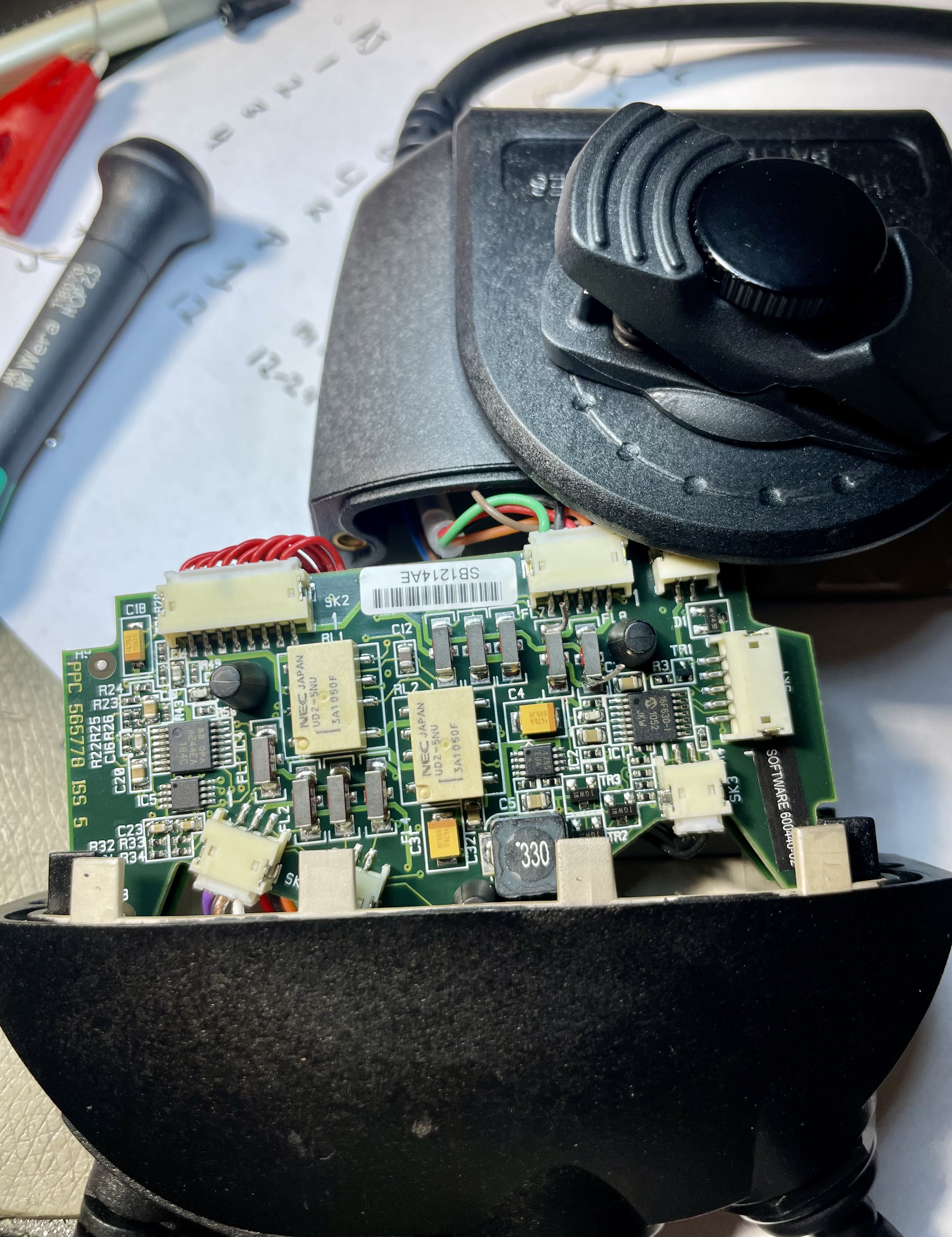
The inside consists of two boards with a cable between them (red). The upper right has the battery and external cable connections, the lower left connector is the microphone connections. A PIC16F630 microcontroller is the only smarts in the device, and seems to control the ANC/TT modes. The 630 was introduced around 2006 or so, dating the design to no earlier than this.
We can also note EMI filters installed for all inputs/outputs, these seem to shield relative to the ground-line internally, and the electronics are not referenced to the chassis/wire shields.
The relays seem to be used to switch in the microphone preamp, and possibly to switch the headset speakers to the internal amplifiers in powered mode. Not visible in the picture is a set of reed-relays that sense the mask-microphone port cover state to switch the microphones around.
I don't see anywhere to e.g. put in a stereo audio input, so stereo models may simply use different PCB's.
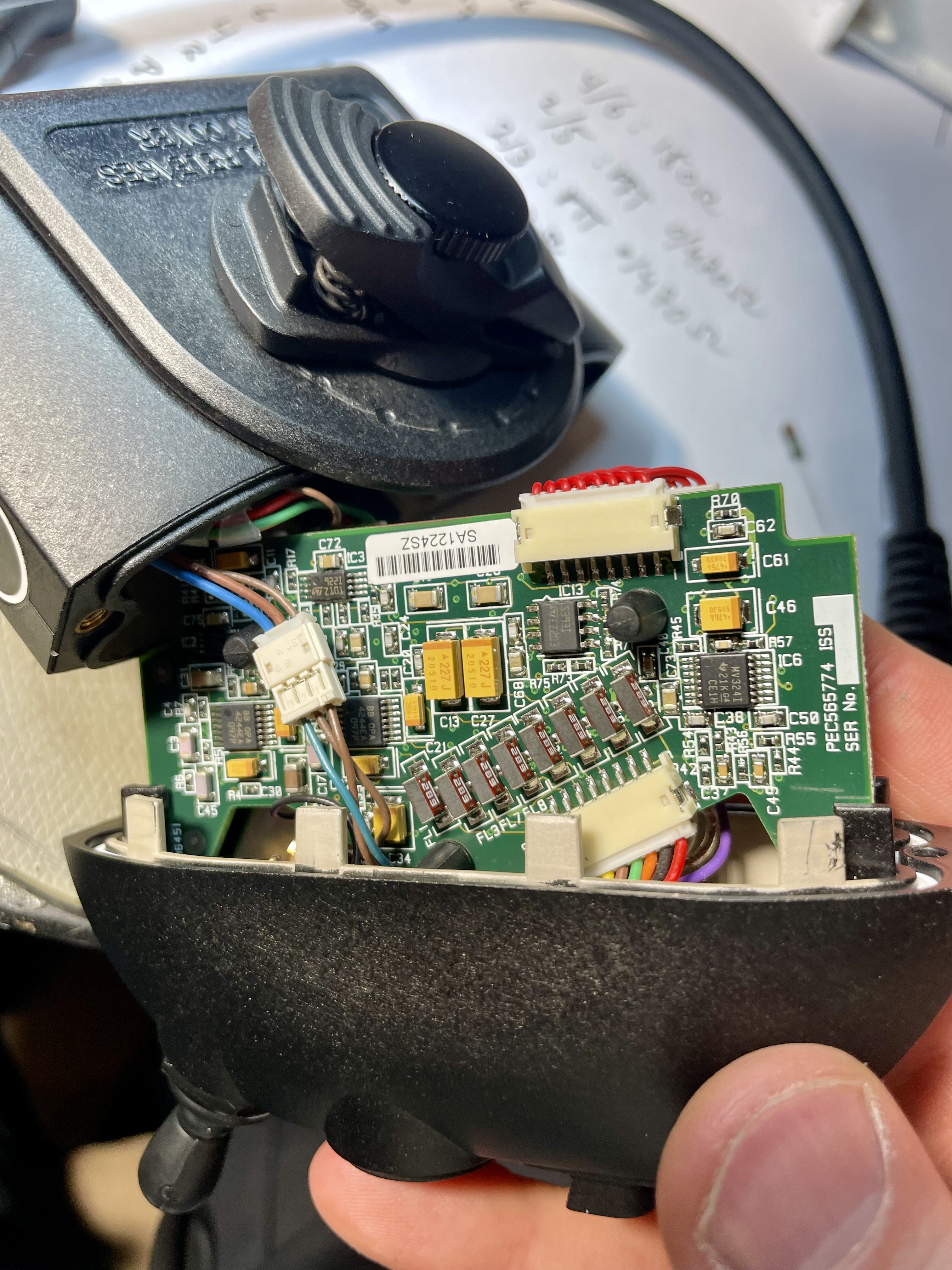
The bottom board contains more discrete analog & digital circuitry. The opamps seem to be OPA4244's, which are decent performance very low power opamps. There seems to be a charge pump generating 3 V from the battery input when in TT battery mode. None of the chips I identified can run directly off a 1.5 V battery so this is probably the main supply for everything.
The OPA4244 is not an amazingly low noise device, but it does seem to be doing an acceptable job at amplifying the dynamic microphone.
An ST TS922 MSOP-8 BiCMOS opamp is also visible, I initially assumed this was driving the speakers. On further review it seems this is used as the microphone pre-amplifier in powered mode. This 10 nV⁄√Hz 4 MHz device is basically adequate for the task.
A slightly better alternative for improved audio may be a TL972IPWR, which has around half the noise. I tried putting this device in and while it did work I can't say I found any noticeable improvement.
The loose wire-wire connector is the PTT signal and the ground line from the external connector. The PTT switch looks to be relatively simple to remove if you wanted to re-wire it.

The PTT case seems to be made of a nylon-glass-fibre composite and seems pretty good. Internally it has a conductive shielding paint.
Appendix – Operator's Manual
